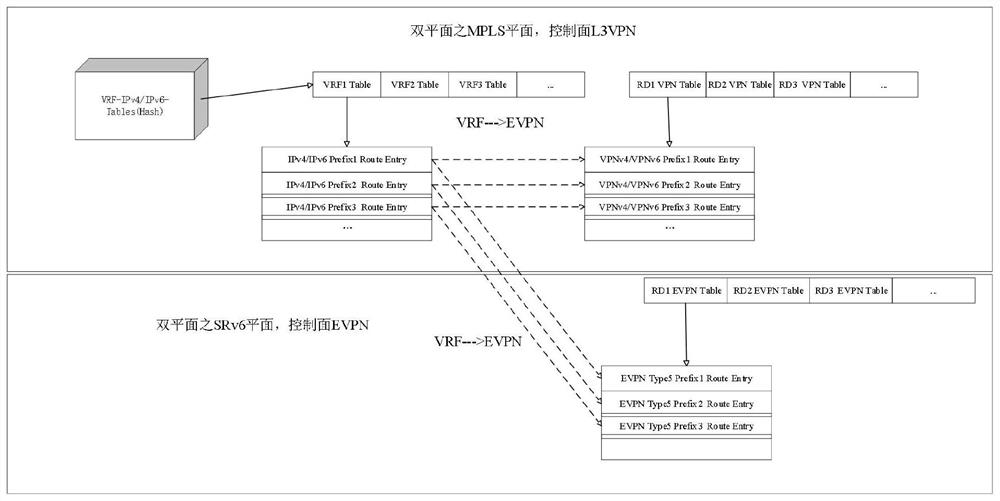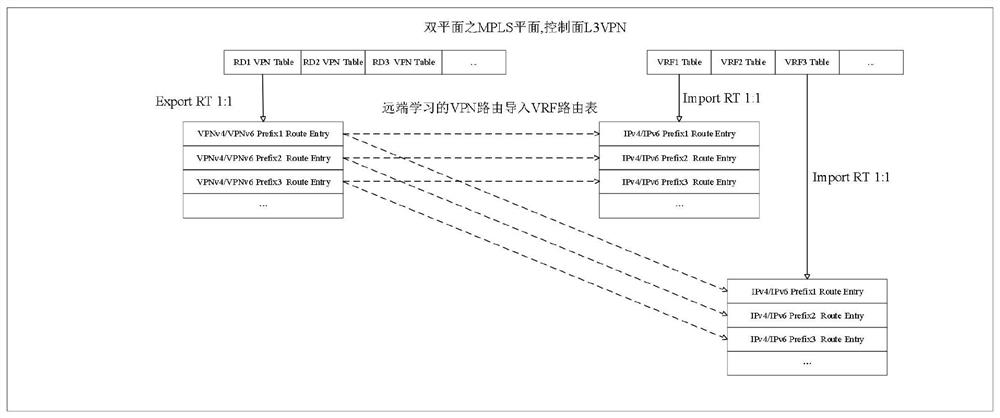Routing memory optimization method and routing memory optimization device in dual plane mode
An optimization method and dual-plane technology, applied in the field of communication, can solve problems such as large memory consumption, and achieve the effects of reducing replication, high performance of routing and sending and receiving processing, and reducing memory consumption.
- Summary
- Abstract
- Description
- Claims
- Application Information
AI Technical Summary
Problems solved by technology
Method used
Image
Examples
Embodiment 1
[0040] refer to Figure 4 , in order to solve the problem of excessive memory consumption caused by routing table expansion, this embodiment provides a routing memory optimization method in dual-plane mode, the routing memory optimization method includes the following steps:
[0041] Step 101: Construct an RD routing table with a routing discriminator as a key, wherein the RD routing table includes multiple routing sub-tables, and each routing sub-table is used to store different types of routing entries.
[0042] In this embodiment, the structure is as Figure 5 As shown in the RD routing table, the RD routing table uses the RD value as the Key for Hash storage, and there are multiple routing sub-tables in each RD routing table, where the routing sub-table includes IPv4 unicast routing sub-table, IPv6 unicast routing sub-table table, IPv4 multicast routing sub-table, IPv6 multicast routing sub-table, EVPN L2 routing sub-table (actually stores Layer 2 routing information of T...
Embodiment 2
[0076] The following is combined with a specific networking scenario, such as Figure 10 As shown, CE1 is dual-homed to PE1 and PE2 nodes, the VRF name on the private network side is VRF1, the RD is 1:1, and the import RT and export RT are both 1:1. CE4 is single-homed to PE2 and belongs to VRF1 like CE1. CE2 is single-homed to PE3, the VRF name on the private network side is VRF2, the RD is 2:2, and the import RT and export RT are both 1:1. CE3 is single-homed to PE3 node, the VRF name on the private network side is VRF1, the RD is 1:1, and the import RT and export RT are both 1:1. Two pairs of PE1, PE2, and PE3 on the public network side establish BGP neighbor relationships. PE1 and CE1, PE2 and CE1, PE2 and CE4, PE3 and CE2, and PE3 and CE3 also establish BGP neighbors respectively. Taking the L3VPN service as an example to illustrate the implementation process of the foregoing routing memory optimization method.
[0077] (1) The IPv4 / IPv6 route generated by the local VRF...
Embodiment 3
[0084] combine Figure 10 , based on the integration of the size and size of the previous routing table, the routing processing performance is comprehensively improved through the adaptive scheduling algorithm. The adaptive algorithm is mainly reflected in PE1, PE2, and PE3, and CE1, CE2, CE3, and CE4 are used as routing Source and destination, without too much description. Such as Figure 11 The service flow chart for routing processing, for PE1 / PE2 / PE3 in the networking diagram, involves the packet ingress phase, routing local processing phase, and packet egress phase.
[0085] Among them, for the message incoming stage, this stage does not cache any messages, and immediately parses out the attributes and routing entries in the message after receiving the Update message, and hangs the route in the scheduling queue waiting for processing.
[0086] The local route processing stage includes route selection, local delivery and neighbor notification of routes. Among them, the t...
PUM
 Login to View More
Login to View More Abstract
Description
Claims
Application Information
 Login to View More
Login to View More - R&D
- Intellectual Property
- Life Sciences
- Materials
- Tech Scout
- Unparalleled Data Quality
- Higher Quality Content
- 60% Fewer Hallucinations
Browse by: Latest US Patents, China's latest patents, Technical Efficacy Thesaurus, Application Domain, Technology Topic, Popular Technical Reports.
© 2025 PatSnap. All rights reserved.Legal|Privacy policy|Modern Slavery Act Transparency Statement|Sitemap|About US| Contact US: help@patsnap.com



